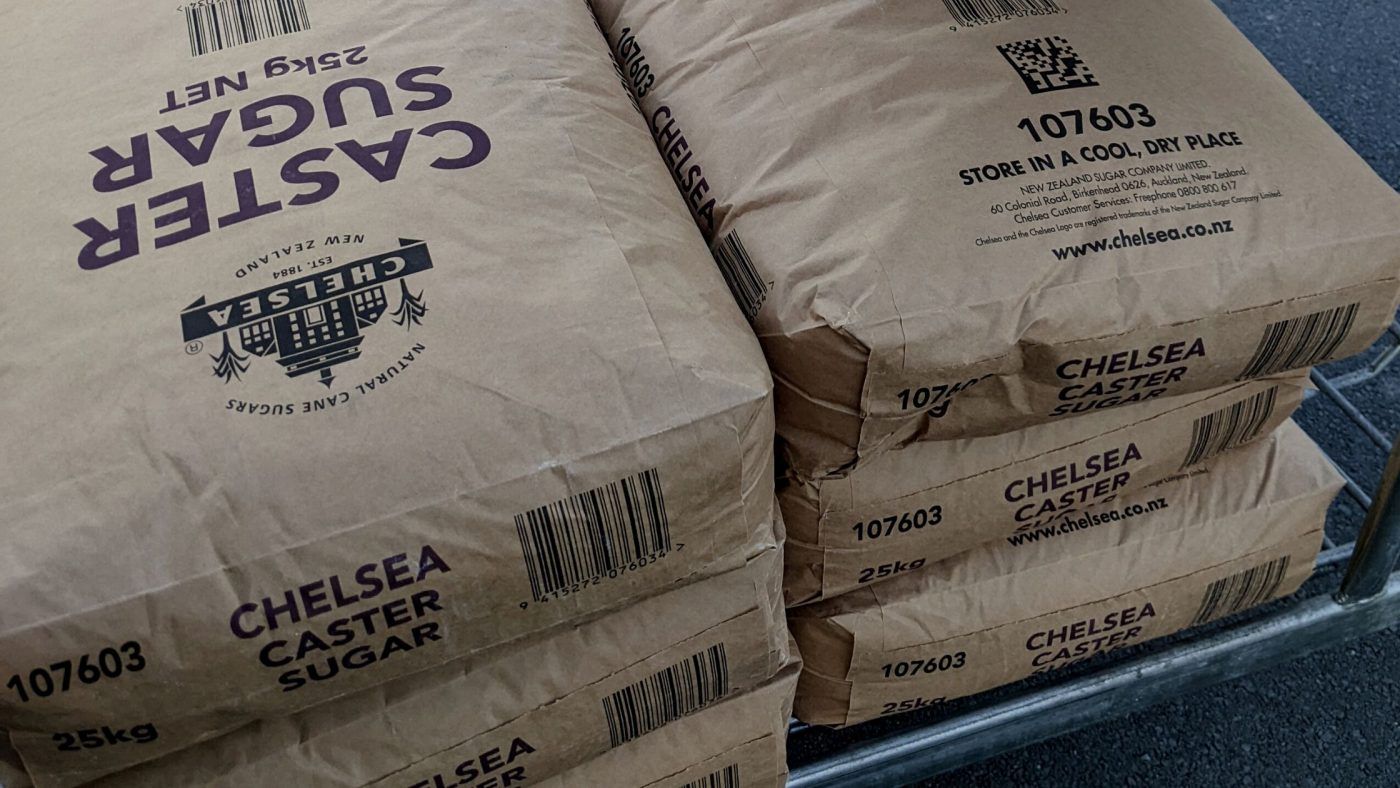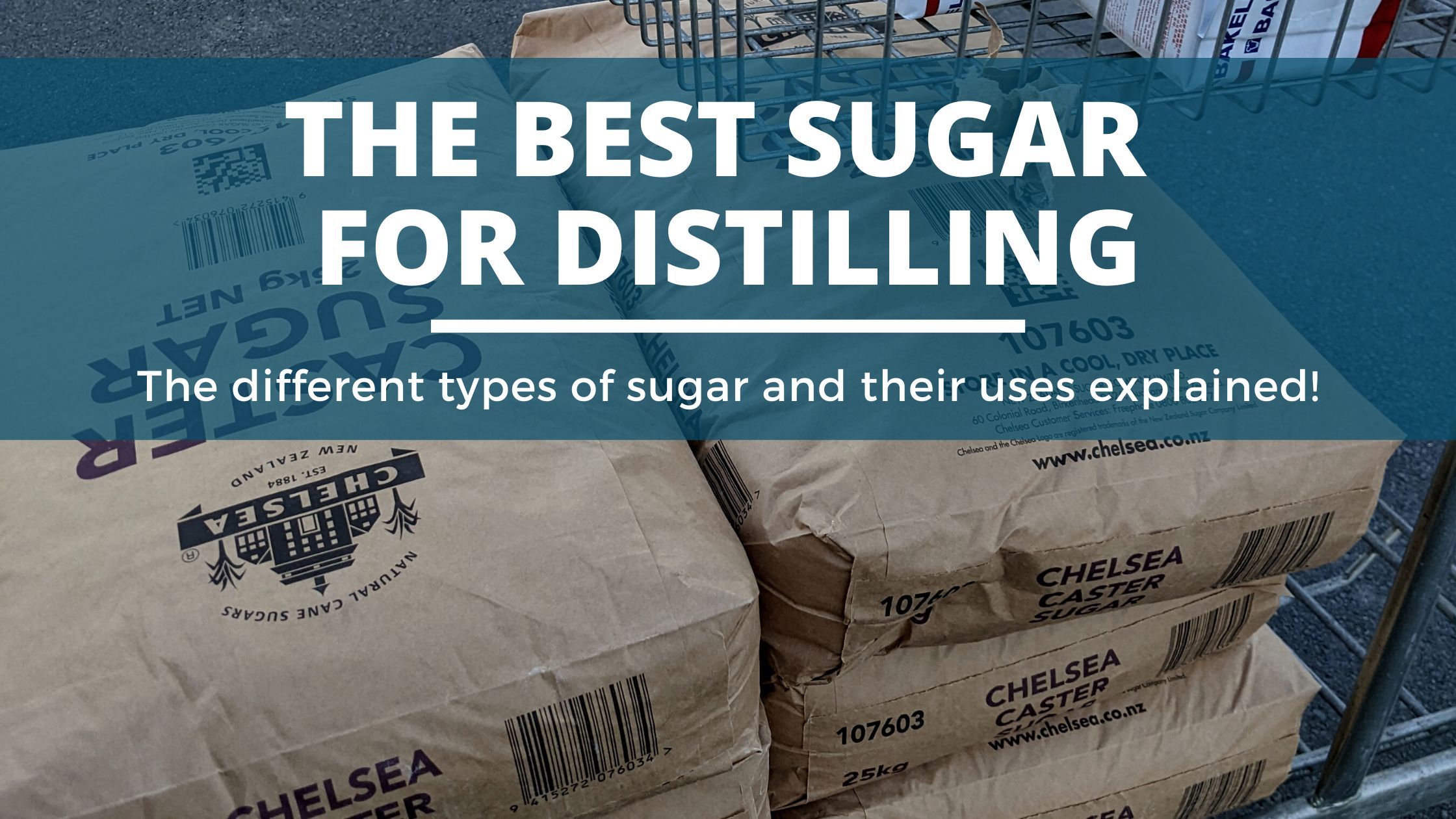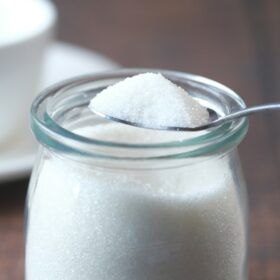Distilling 101, Ingredients, Sugars, Starches and Grains
The Best Sugar for Distilling (Sugar Explained!)
To make the most of your brewing and distilling experience, you need to have a good understanding of which is the best sugar for distilling and what it does.
Sugar and its alternatives can provide you with a host of opportunities to fine-tune your next batch.
Table of Contents
What is Sugar?
Sucrose is a molecule composed of 12 atoms of carbon, 22 atoms of hydrogen, and 11 atoms of oxygen (C12H22011), otherwise known as sugar.
Sugar is a combination of two simpler sugars: fructose and glucose. When following recipes, added acid, like lemon juice or cream of tartar, will cause sucrose to break down into these components.
When sugar is added to water, the sugar crystals will dissolve, turning it into a solution. However, you cannot dissolve an infinite amount of sugar into a fixed volume of water. When you have dissolved as much sugar as can be dissolved, this is where the solution can be considered saturated.
This point of saturation is different at different temperatures. The higher the temperature, the more sugar is held in the solution.
The most common type of sugar is glucose. Glucose is a monosaccharide, hexose-type, sugar. This means each molecule contains six carbon atoms. Fructose and galactose are both hexoses that are relevant to brewing. Fundamentally, these monosaccharides are all the same but are isomers of each other.
If we are to examine the sugars that are found in typical beer wort made from 2-row barley base malt, we notice that the main constituent of wort is maltose. Generally, this comprises around 50% of the total carbohydrates in the wort. Followed by this is maltotriose, which consists of 18% of the total carbohydrates. What is left of the wort is made up of 10% glucose, 8% fructose, and dextrins, which account for 12% of the wort carbohydrates.
How is Sugar Used in Distilling?
If you are looking to make a simple and neutral spirit like vodka, using a sugar wash is recommended. This is due to the great results that this process provides and the simplicity of the process.
Using sugar is cheaper than using grains and malts, which will also add extra work when using a column still to strip the flavor.
A sugar wash is an easy process that offers a relatively low risk of making mistakes.
When using a sugar wash, the fermentation time will be a bit longer compared to using Turbo yeasts, which is a special strain of yeast that can tolerate high levels of alcohol – occasionally up to 24%
A Turbo yeast packet contains a blend of yeast nutrients that will help the yeast to reach a higher alcohol level.
The recipe below is used to produce a sugar wash of 25 liters and approximately 14.4% ABV once it is fermented. This process is required to distill a “Neutral Spirit.”
The ingredients needed are as follows:
- 150 G Still Spirits Distiller’s Nutrient Light Spirits
- 1 Sachet of Still Spirits Distiller’s Yeast Vodka 20g
- 6 KG sugar
- 1 Turbo Carbon
- 1 Turbo Clean
The directions for the process are listed below:
- Add 21 liters of water, which is roughly 30 degrees Celsius, to your cleaned and sanitized fermenter.
- Add 6 kg of sucrose or 6.6 kg of dextrose and stir until it dissolves. Now, you should have about 25 liters of sugar solution that is ready for fermentation.
- Take your Distiller’s Nutrient and shake it well.
- Take the yeast as well as the nutrients and add them both directly into the fermentation vessel and stir well till it dissolves.
- Fit the lid and airlock.
- Leave it to ferment at 20 to 32 degrees Celsius for optimum performance and quality. You can also add the turbo carbon to absorb any impurities produced by the yeast during fermentation. This will improve the quality of your alcohol.
- Once your airlocks stop bubbling, it’s the indication the fermentation is complete. You can expect this in approximately 7 days. Tasting the wash at this stage reveals it to be dry and not sweet at all.
- Now, you can leave your wash to stand for one to two days for any remaining solids and yeast to “settle out.” Turbo clear will speed up the clarification process.
- You can then distill your wash to make your spirit. The wash should be siphoned into your still, leaving the sediment behind.
- After your first distillation, you can filter the spirit through a carbon filter to polish the spirit for a cleaner, smoother flavor.
Distiller’s Sugar Wash Recipe
Ingredients
- 150 gm Still Spirits Distiller’s Nutrient Light Spirits
- 1 sachet Still Spirits Distiller’s Yeast Vodka 20 g
- 1 kg sugar
- 1 Turbo Carbon
- 1 Turbo Clean
Instructions
The directions for the process:
- Step 1: Add 21 liters of water, which is roughly 30 degrees Celsius, to your cleaned and sanitized fermenter.
- Step 2: Add 6 kg of sucrose or 6.6 kg of dextrose and stir until it dissolves. Now, you should have about 25 liters of sugar solution that is ready for fermentation.
- Step 3: Take your Distiller’s Nutrient and shake it well.
- Step 4: Take the yeast as well as the nutrients and add them both directly into the fermentation vessel and stir well till it dissolves.
- Step 5: Fit the lid and airlock.
- Step 6: Leave it to ferment at 20 to 32 degrees Celsius for optimum performance and quality. You can also add the turbo carbon to absorb any impurities produced by the yeast during fermentation. This will improve the quality of your alcohol.
- Step 7: Once your airlocks stop bubbling, it’s the indication the fermentation is complete. You can expect this in approximately 7 days. Tasting the wash at this stage reveals it to be dry and not sweet at all.
- Step 8: Now, you can leave your wash to stand for one to two days for any remaining solids and yeast to “settle out.” Turbo clear will speed up the clarification process.
- Step 9: You can then distill your wash to make your spirit. The wash should be siphoned into your still, leaving the sediment behind.
- Step 10: After your first distillation, you can filter the spirit through a carbon filter to polish the spirit for a cleaner, smoother flavor.
How Much Sugar Do I Need to Make a Bottle of Spirits?
Depending on the yeast used, one liter of 90% alcohol will require about 2kgs of sugar. So, to produce a 750ml bottle of vodka with an alcohol percentage of 43%, you would need 780g of sugar.

Different Types of Sugar Explained
There are two main types of sugar; simple sugars, and compound sugars.
Simple sugar is a monosaccharide. This means that they cannot be broken down to form simpler sugars. Simple sugars are the easiest type of sugar for the yeast to consume. This is due to it being 100% fermentable.
Fructose or fruit sugar is generally the sweetest part of sugar. It is a simple sugar that is found in honey, fruit, and many root vegetables.
Glucose or corn sugar is normally combined with other sugars as it is a less sweet sugar. This is another simple sugar that is often processed from various starches, like potatoes, corn, or wheat.
However, compound sugar is considered a disaccharide, which means that it is composed of two simple sugars that are bonded together. The yeast would have to first break down the bond between the sugar molecules, which can lead to a less efficient fermentation process.
Sucrose, otherwise known as table sugar, is a compound of both glucose and fructose which is mainly found in sugar cane stems or beetroots.
White Sugars
1. Dextrose
Dextrose Monohydrate is brewing sugar that is often referred to as “corn sugar” or “glucose.” It can either be used instead of white sugar for fermentation, or as a primer for your beer when bottling or kegging. This is where it will dissolve more quickly than white sugar and ferments 100%.
Dextrose is usually made from corn or wheat that is chemically identical to glucose. It is often used in baking products as a sweetener. It is commonly found in processed foods and corn syrup.
2. White Sugar
White sugar is made from sugar cane and sugar beets. The juice from the plants is boiled down to remove any moisture before crystallizing the sugar.
There are a few varieties of white sugar, and each variety has a different use when baking, cooking, and distilling. These varieties are coarse grain, granulated sugar, caster sugar (very fine sugar), confectioner’s sugar (powdered sugar), and finally, lump sugar, otherwise known as sugar cubes.
3. Caster Sugar
This type of sugar is granulated with a very fine consistency. Is also known as superfine sugar as it contains grains that are a lot finer than normal table sugar. However, it is not as fine as a confectioner’s sugar.
Because castor sugar is a very fine granulated sugar, it dissolves instantly and makes it unnecessary to stir your batch when brewing alcohol.
Brown Sugars
4. Demerara
This is a light brown sugar with large golden crystals and is quite popular in England. The large golden crystals are slightly sticky due to the adhering molasses. It is often used in tea, coffee, or over hot cereals like porridge.
5. Muscovado/Barbados
A British specialty brown sugar that is dark brown with a strong molasses flavor. The sugar crystals are slightly coarser and stickier in texture compared to “normal” brown sugar.
6. Free-flowing
Free-flowing brown sugars are products specially produced by a co-crystallization process. The process produces fine, powder-like brown sugar. This sugar is not as moist as “regular” brown sugar. Because of this, it prevents clumping and is “free-flowing” like white sugar.
7. Turbinado
This is raw sugar that is only partially processed. This means that only the surface molasses is washed off. It is blond with a brown tinge. It is often used in teas and other beverages.
Alternative Sugars
8. Honey
A honey fermentation process removes a lot of honey’s sweetness. If you were to use a spirit maker and distill from orange blossom honey, your spirit’s final product will have a citrusy, crisp flavor.
To make mead or honey wine, you need to ferment honey with water. Like beer, mead is often flavored with fruits, spices, grains, or hops. Though it is usually higher in alcohol than beer and more on par with grape wine. The ABV is generally between 8 and 20%.
9. Stevia
It might not be the most common option, but stevia is used to sweeten wine when it is time to bottle your product. How this is done, is by putting some wine in a glass from your glass carboy and simply adding stevia. You should taste its sweetness from there.
10. Liquid Sugars
There are several types of liquid sugar. Liquid sugar, or sucrose, is white granulated sugar that is dissolved in boiling water before it is used. This type of sugar is ideal for recipes that require dissolved sugar. Amber liquid sugar is a darker sugar and can be used in foods where a brown color is desired.
What is the Best Sugar for Distilling?
Each distiller will have their own set process and decide on sugar that works for them. However, generally, the best type of sugar to use when distilling alcohol is white sugar.
This is because the pure sugar quantity is higher than other sugars and offers the least number of impurities. Simply put, you will get more alcohol when using white sugar compared to other sugars.
1. The Best Sugar for Distilling Rum
Generally, when distilling rum, molasses, sugar cane juice, and sugar cane syrup are the three best raw materials to use.
Extracting sugar from sugar cane is a process that produces a by-product called molasses, which is what rum is made from. The sugar cane is chopped and crushed to extract the juice. That juice is then boiled to reduce the water content and left behind is a syrup known as “wet sugar”. This sugar is comprised of approximately 30% sugar.
This is usually white sugar.
When combined with a good rum yeast, this combination of sugar creates the key flavors desired in a rum.
2. The Best Sugar for Distilling Vodka
Rum must be made from sugar cane, whereas vodka can be made from any fruit, root, starch or grain (which includes sugar cane). The difference between the two lies within the process as well as the definition of the spirit.
For your alcohol to be considered vodka by the Alcohol Beverage Control, your vodka must be distilled above 190.
Use a good vodka yeast to get a nice clean ferment out of your wash
3. The Best Sugar for Distilling Moonshine
Moonshine can be made with either white or brown sugar. But what exactly is moonshine?
The health benefits of brown sugar over white sugar are so minimal that it does not make all that much of a difference which one you use. However, you will need to consider the color of the sugar as this will affect the color of your moonshine.
4. The Best Sugar for Distilling Tequila
If you are distilling alcohol and decide it is tequila that you are after, you will need to use agave sugar. To produce 100% tequila, this is the only sugar that can be used.
You can make other kinds of tequila which would then require either sugar cane, molasses, or corn syrups that can be added to levels of 49%. Sugary Worts that are used to produce 100% tequila will have sugar concentrations that range from 4-10%.
This article talks a bit more about how to make tequila, what makes tequila TEQUILA, and what yeast you should use when fermenting an agave wash.
Frequently Asked Questions
Q. What’s the difference between glucose, dextrose, and maltose?
Glucose and dextrose are considered the same thing.
Maltose is made of two glucose units. Table sugar, otherwise known as sucrose, is made of one glucose and one fructose. Maltose is made from the breakdown of starch. This is a long chain of many glucose units. The enzymes in your stomach will break down these chains of glucose until they are maltose.
Q. Is Dextrose or white sugar better for distilling?
The main difference between the two is the difference in the flavor profile. This applies to even high-strength reflux distillations.
Dextrose tends to make a softer finished spirit.
The final choice is yours as it does depend on what alcohol you are distilling. For example, dextrose is great for making whiskey, whereas rum and vodka would require sugar for the best results. Not only because of flavoring, but also because it will work out to be a lot cheaper too.










I have a 120 copper still and when I do a ferment of 42 litres of water at 30 degrees with 16 kg of sugar and the yeast etc. When I distill it, I am only getting about 15 litres of 60% alcohol, 5 litres of 20% and 5 litres of 10%. can you please give me some advice as to what I am doing wrong with such a low alcohol content, I would appreciate any advice that you can give me.
Hi Peter, interesting question. Let’s just look at the fermentation side of things for now. Using 16kg of sugar for 42L of water is A LOT! That would make a 22% wash and any yeast would struggle to get that high before dying. Did you measure the starting and final gravity? How much alcohol are you actually producing?